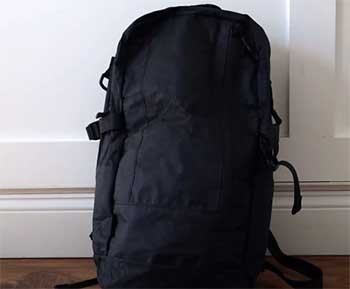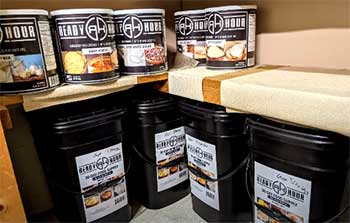For serious backpackers, selecting the right pack isn’t a task taken lightly. The argument often boils down to two main contenders: Robic and Dyneema packs. But what makes these two materials different, and which one should you choose for your adventures?
Let’s delve into the details.
A Brief Comparison Table
| Aspect | Robic | Dyneema |
| Durability | High | Medium |
| Abrasion Resistance | High | Low |
| Tear/Puncture Resistance | Medium | High |
| Weight | Medium | Low (ultralight) |
| Cost | Lower | Higher |
| Waterproofness | Water-resistant | Waterproof |
What Are Robic And Dyneema Packs?
Robic and Dyneema are high-tech fabrics used in backpack construction for their remarkable strength-to-weight ratios. Robic, a type of nylon fabric, is known for its durability and resistance.
Dyneema, on the other hand, is praised for its ultra-lightweight properties and exceptional tear resistance.
Robic Packs: Built to Last
Robic packs, often used by backpackers and hikers, are reputed for their robustness. The material, a variant of nylon, offers a superior combination of strength and durability. Its secret lies in its high-tenacity yarns that provide exceptional resistance to abrasion and stress.
Pros of Robic Packs

Robic packs have three major benefits:
- Durability: The high-tenacity nylon fibers in Robic packs significantly enhance their longevity. They are more resistant to wear and tear, even under stressful conditions, making them perfect for long and strenuous trips.
- Cost-effectiveness: Robic packs generally come at a lower cost than Dyneema packs. For those budget-conscious hikers, a Robic pack provides a solid balance of performance and affordability.
- Water Resistance: Though not completely waterproof, Robic material has excellent water resistance, providing good protection against light to moderate rainfall.
Cons of Robic Packs
However, there are a few disadvantages to consider:
- Weight: Robic packs are typically heavier than their Dyneema counterparts. For those seeking ultra-light backpacking, this could be a potential drawback.
- Limited Waterproofness: While Robic material offers good water resistance, it’s not completely waterproof. For harsh weather conditions, you might need to consider additional waterproofing measures.
Also Read: Comparison of KUIU And Eberlestock Backpacks.
Dyneema Packs: The Ultra-light Champion
Dyneema, often referred to as “the world’s strongest fiber,” is gaining popularity among ultra-light backpackers. It’s a high-tech polyethylene fiber offering unparalleled strength-to-weight ratios.
Pros of Dyneema Packs

Dyneema packs have some unique advantages:
- Ultra-light: Dyneema packs are incredibly light. This feature makes them an excellent choice for backpackers aiming to reduce their pack weight.
- High Tear Resistance: Dyneema fabric boasts exceptional tear and puncture resistance. This attribute significantly enhances the lifespan of Dyneema packs.
- Waterproof: Unlike Robic, Dyneema material is completely waterproof, making it a reliable companion in adverse weather conditions.
Cons of Dyneema Packs
Despite the benefits, there are a couple of drawbacks:
- Cost: Dyneema packs are more expensive compared to Robic packs. The high cost might be a limiting factor for budget-conscious backpackers.
- Limited Abrasion Resistance: While Dyneema has excellent tear resistance, its abrasion resistance is lower than that of Robic. This might shorten its lifespan if frequently exposed to rough conditions.
Key Differences Between Robic and Dyneema Packs
When deciding between a Robic and a Dyneema pack, understanding their key differences can help guide your choice. Both materials have unique characteristics that make them suitable for different use-cases.
This comprehensive guide will dive into the differences in durability, weight, cost, and waterproofness.
- Durability
When it comes to durability, Robic is considered a winner. This material is specifically designed to resist the wear and tear of rigorous outdoor activities. Robic’s high-tenacity nylon fibers significantly enhance its longevity, meaning your backpack will withstand countless adventures.
It’s worth mentioning that Robic also has excellent abrasion resistance, a critical factor for a backpack used in challenging environments with potential sharp or rough surfaces.
On the other hand, while Dyneema is renowned for its high tear and puncture resistance, it falls short on abrasion resistance. This means that while Dyneema packs can resist being punctured, they can wear out quicker than Robic packs when subjected to continuous friction or rough surfaces.
- Weight
Dyneema takes the crown for being the lighter material. Dyneema packs are designed to be incredibly lightweight, making them ideal for ultralight backpacking.
Ultralight backpackers often need to count every ounce to maintain their pack weight as low as possible, and a Dyneema pack helps achieve this without compromising strength or tear resistance.
Contrarily, Robic packs are typically heavier than Dyneema packs. Although Robic is also considered a lightweight material, it doesn’t quite match the extreme lightness of Dyneema.
For some hikers, the slight increase in weight might not be a significant factor, but for those striving for the lightest pack possible, Dyneema would be the better choice.
- Cost
In terms of cost, Robic packs usually come with a smaller price tag. The production process for Robic material is less complex and more cost-effective, which is reflected in the final price of the backpacks.
Dyneema, given its high-tech properties and the complex process involved in its production, results in more expensive packs. While the extra investment might be justified for some users given its unique properties, budget-conscious backpackers might lean towards the more affordable Robic packs.
- Waterproofness
Finally, waterproofness is another crucial factor to consider. Dyneema material is entirely waterproof, making it an excellent choice for backpackers who frequent rainy environments or cross rivers and streams during their adventures.
Robic, however, is water-resistant but not entirely waterproof. It can protect your gear from light to moderate rain, but in heavy downpours or submersions, water might seep through.
For full waterproof protection, Robic packs might need additional waterproofing methods, such as rain covers or liners.
Also Read: Differences Between X-Pac And Cordura Backpacks.
Frequently Asked Questions (FAQ)
Let’s answer some common questions about Robic and Dyneema materials:
Robic fabric is water-resistant, meaning it can withstand light to moderate rain, but it is not fully waterproof. For heavy rain, additional waterproofing methods might be needed.
Robic is a type of high-tenacity nylon. It’s known for its superior strength, durability, and resistance to abrasion, making it an ideal material for backpack construction.
Yes, Robic nylon is incredibly durable due to its high-tenacity fibers, which enhance its resistance to wear and tear. It’s particularly suited to challenging hiking or backpacking conditions.
“Ultra” typically refers to ultra-high-molecular-weight polyethylene (UHMWPE), which is the same material as Dyneema. Therefore, they are not different but the same material marketed under different names.
Conclusion
In conclusion, both Robic and Dyneema packs offer unique benefits. The choice between the two ultimately boils down to personal preference and your specific backpacking needs. If durability and cost-effectiveness are your priorities, a Robic pack is your go-to.
On the other hand, if you’re looking for an ultra-light, waterproof, and tear-resistant pack, a Dyneema pack might be your best bet. Happy backpacking!

